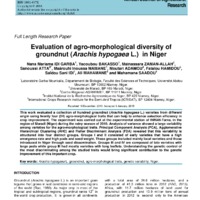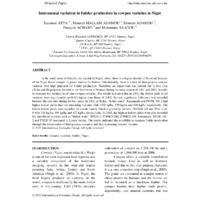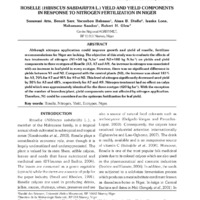Recherche
5 items
Estimates of Phenotypic and Genotypic Variance and Heritability in Eighty Nine Bambara Groundnut Vigna subterranea (L.) Verdcourt] Accessions Collected from Six Regions of Niger
The bambara groundnut [Vigna subterranea (L.) Verdc. (Fabaceae)] is a legume mainly cultivated by women, for the nutritional quality of these seeds. It is a so-called minor culture and the improvement of the plant and its popularization remains to be promoted. The objective of this present work is to evaluate the genetic variability of bambara groundnut accessions. The experiment was carried out according to a completely randomized block device with four replications. Twenty-two (22) characters including four (4) phenological, four (4) morphological and fourteen (14) related to yield were evaluated for accessions characterization. Descriptive analysis showed significant differences. The coefficients of variation ranged from 3.51% (maturity date) to 38.87% (shell weight). Significantly high values (CV˃20%) for 8 of the metric parameters were observed. Pod weight per plant and seed weight per plant (r=0.943), yield in kg/ha (r=0.943); seed weight per plant and yield in kg/ha (r=0.999) showed the strongest correlations. The phenotypic and genotypic coefficients of variation were high for dry biomass weight (PCV=42.23%; GCV=28.40%), shell weight (PCV=63.46%; GCV=22.46%) and 100-seed weight (PCV=25.57%; GCV=25.25%). Maturity date (95.77%) and 100-seed weight (99.84%) had high heritabilities. Broad-sense heritability and genetic gain are high for 100-seed weight (H2=99.84%; GA=52.58%). The Ascending hierarchical classification produced four groups of which group 4 is the most efficient in yield with short (20.58cm) early accessions (80.32 days). Groups 1 and 2 include, late accessions (~22cm) with respectively maturity dates (DM=85.67 days and DM=86.53 days.
Evaluation of agro-morphological diversity of groundnut (Arachis hypogaea L.) in Niger
This work evaluated a collection of hundred groundnut (Arachis hypogaea L.) varieties from different origin using twenty four (24) agro-morphological traits that can help to enhance selection efficiency in crop improvement. The experiment was carried out at the experimental station of INRAN-Tarna, in the region of Maradi (Niger) during the rainy season of 2010. Analysis of variance showed a large variability among varieties for the agro-morphological traits. Principal Component Analysis (PCA), Agglomerative Hierarchical Clustering (AHC) and Fisher Discriminant Analysis (FDA) revealed that this variability is structured into four distinct groups. Groups I and II consisted of early varieties that have a high emergence rate and high pods and seed weight. These groups included mainly local varieties and those introduced in Niger through seed dissemination. Groups III and IV are composed of late varieties with large pods while group III had mostly varieties with long leaflets. Understanding the genetic control of the most discriminating among the studied traits would bring significant contribution to the genetic improvement of this important crop.
Interannual variation in fodder production in cowpea varieties in Niger
In the south areas of Niamey, the capital of Niger, where there is a higher density of livestock because of the Niger River, cowpea is grown mainly for fodder. Unfortunately, there is a lack of dual-purpose cowpea varieties with high potential for fodder production. Therefore, an experiment was carried out in two sites (Ticko and Bogodjotou) located in the Southwest of Niamey during the rainy season of 2001 and 2002, in order to compare the production of nine cowpea varieties. The results indicated that in 2001, the fodder yield of all varieties were significantly (p<0.01) higher than those of 2002. But not significant difference was recorded between the two sites during the two years. In 2001, at Ticko, “Baban waké", Kanannado and IT93K-398-2 had higher fodder yields than the remaining varieties with 1032 kg/ha, 879 kg/ha and 866 kg/ha respectively. The lowest fodder yields were recorded for Locale variety which is grown by farmers, IT89KD-349 and TVu 1234- 9 with 715 kg/ha, 499 kg/ha and 677 kg/ha, respectively. In 2002, the highest fodder yields were also recorded for introduced varieties such as “Baban waké", IN92E-3, IT89KD-288, IT89KD-349, Kanannado, IT93K-398- 2 and TN256-87 compared to Locale variety. The results indicated the possibility to increase fodder production through the introduction of dual-purpose cowpeas and thus increasing farmers’ income. © 2011 International Formulae Group. All rights reserved.
MICRO-ELEMENT CONTENTS IN ROSELLE (HIBISCUS SABDARIFFA L.) AT DIFFERENT GROWTH STAGES
In the western Sahel, leaves of Roselle (Hibiscus sabdariffa) have considerable economic importance because of their nutritional and medical uses. These plant organs are used to supplement nutrients provided by cereals such as millet and sorghum. However, there is a lack of information on the nutrient composition of these plant organs of Roselle at different growth stages. Therefore, the experiment was carried out under rainfall conditions during the 2006 rainy season (from July to September) at the experimental station of the Agrhymet Regional Centre in Niamey (Niger). The content of the micronutrients Fe, Mn, Cu and Zn in leaves of three ecotypes of Roselle (A3, A7 and A9) at three growth stages, vegetative (stage I), flowering (stage II), and mature (stage III) was determined. The experimental design was a randomized complete block with four replicates and one variable (ecotype). Results indicated that at stage I, ecotype A3 had higher Fe content in leaves. In addition, A3 had also the highest Zn content in leaves at stage I. For all three ecotypes, Fe and Zn content in the leaves decreased significantly (p<0.05) from stage I to stage II, then remained constant until stage III. For Fe, the decrease between stage I and II was 37& for A3 and 50&, respectively for A7 and A9. The corresponding decrease of Zn content was 30& for A7 and 50&, respectively, for A3 and A9. The Mn content in the leaves of Roselle was similar for the three ecotypes at stage I, thereafter increased continuously during plant growth. From stage I to II, the increase was about 90&, 70& and 50&, respectively for A9, A7 and A3. From stage II to III, the increase in Mn content in the leaves was significantly (p<0.05) higher for A3 and A7, respectively 180& and 80&. At stages I and II, the highest Cu content was recorded for A3 and the lowest one for A7. During the whole cycle of plant growth, the Cu content in the leaves was relatively constant for A9. In contrast, Cu content in the leaves decreased for the remaining ecotypes. Therefore the vegetative stage corresponding to 25 days after sowing is the recommended optimal harvest time of Roselle to maximise on the nutrients.
ROSELLE (HIBISCUS SABDARIFFA L.) YIELD AND YIELD COMPONENTS IN RESPONSE TO NITROGEN FERTILIZATION IN NIGER
Although nitrogen application could improve growth and yield of roselle, fertilizer recommendations for Niger are lacking. The objective of this study was to evaluate the effects of two treatments of nitrogen (N1=50 kg N,ha-1 and N2=100 kg N.ha-1) on yields and yield components in three ecotypes of Roselle (A3, A7 and A9). An increase in nitrogen was associated with an increase in leaf yield in every ecotype. However, there was no significant difference in yields between N1 and N2. Compared with the control plants (N0), the increase was about 181& for A3, 70& for A7 and 95& for A9 at N2. This level of nitrogen significantly decreased seed yield by 30& for A3 and 48&, respectively for A7 and A9. Nitrogen treatment had no effect on calyx yield which was approximately identical for the three ecotype (420 kg ha-1). With the exception of the number of branches/plant, yield components were not affected by nitrogen application. Therefore, N1 could be considered as the optimum fertilization for leaf yield.




